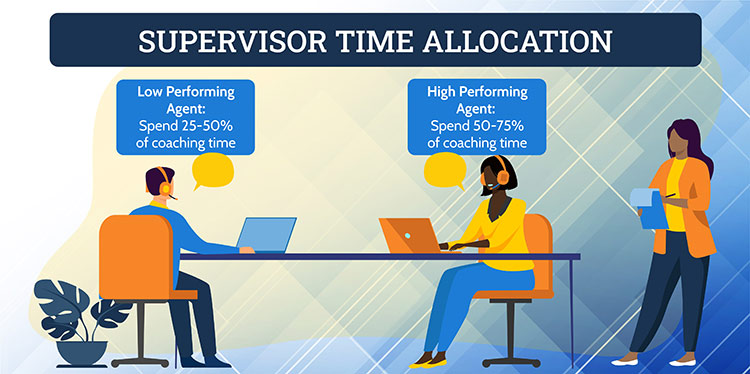Who are the Right Agents to Coach for Improving Csat?
As most call center leaders know, supervisor coaching agents is critical for helping a call center improve customer service. SQM research shows, in most cases, call center overall customer satisfaction (Csat) improvement comes from agents who are the high Csat performers versus average or below Csat performers
Traditional thinking is that when call center overall Csat improves, it comes from improving agents in the 3rd and 4th quartile Csat performance levels. As a result, supervisors have allocated more agent coaching time to improve agent Csat performance with the lowest Csat agent performers.
However, given that most call center Csat improvement comes from agents with high Csat performance versus agents with average or below Csat performance level, it is worth asking, “what is the right supervisor coaching time allocation for agent customer service improvement”?
Put differently, which agents a supervisor spends most of their time coaching will play a significant role in the call center’s overall Csat. Especially when considering the typical call center, only 50% of supervisor time is for coaching agents.
The starting point for a supervisor to be an effective coach to help improve agent Csat for resolving an inquiry or problem requires measuring agent Csat performance. Csat measurement is typically done by conducting a post-call survey within one day of a customer interacting with a call center. Most call centers measuring agent Csat conduct 5 to 10 surveys per agent per month.
Another essential aspect of supervisor coaching for improving an agent Csat performance is to coach the coach. Unfortunately, many call center leaders assume supervisors can coach agents to improve Csat. The reality is that there are significant differences in how some supervisors coach their agents on how to improve Csat. Therefore, a best practice is to certify that a supervisor has the knowledge, abilities, skills, and track record to improve agent Csat.
At SQM, we recommend that supervisors invest approximately 50 to 75% of their time with high Csat performing agents and 25 to 50% of their time with average or below Csat performing agents. Again, in most cases, supervisors should allocate most of their time coaching with high-performing Csat agents to help improve a call center’s overall Csat. Furthermore, focusing on high-performing Csat agents, it is more likely the call center’s overall Csat will improve.

Low Csat performing agents have a will and skill Issues in many cases. Moreover, when SQM evaluated agents, who were underperforming for providing positive customer experience (CX), we determined that when a customer was dissatisfied with an agent, 62% of the time it was due to a will issue, and 38% of the time was due to a skill issue. Moreover, the fixing agent will issue for low-performing Csat agents to improve a call center’s overall Csat can be challenging to achieve. Therefore, a VoC performance system is an excellent method to address agent will issues. is an excellent method to address agent will issues.
We all know the reality is that the low agent Csat performers tend to draw disproportionately on the supervisor’s time at the expense of the greater opportunity with the high Csat performers. For this reason, SQM advocates strict adherence to no more than 50% of supervisor time is for coaching average or below Csat performing agents.
We have seen call centers improve their First Call Resolution and Csat performance by terminating the low agent Csat performers. However, terminating agents for low Csat is not common because call center leaders are reluctant to terminate an agent based on customer satisfaction surveys. At SQM, we consider terminating an agent for low Csat a good practice if the customer survey sample is large enough or feedback about the agent warranted their termination.
In closing, the whole notion of providing limited agent coaching for average or below Csat performers is counterintuitive and controversial. Just about every supervisor can come up with a story about a low Csat performer turning around their performance. However, SQM’s CX research has shown that over 80% of call centers that improved overall Csat came from high Csat performing agents. So the issue is not to stop having a supervisor coaching low Csat performing agents but to increase the supervisor coaching of high Csat performing agents to improve a call center’s overall Csat.
Quick Related Links
First Call Resolution Definition First Call Resolution PPT First Call Resolution Benefits First Call Resolution Strategies First Call Resolution Operating Philosophy Coaching Case Study Survey Data Calculate First Call Resolution Top 10 Call Center Metrics VoC Closed-Loop Outside-In or Inside-Out Journey Mapping Agent Coaching Sample Size Calculator Good to Great Customer Service

